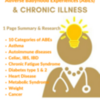I got a big splinter in my index finger recently when I was lightly sanding door trim in preparation to prime it. It hurt and I cursed, which is a very satisfying bit of fight response that arises spontaneously now, and that I don't suppress when I'm in my own setting such as at home with no witnesses. It's a response to being hurt and "attacked," such as by the door frame I thought would be happy with its makeover.

I took the splinter in stride as just a part of painting project mode. It was so large that I pulled it out easily without even needing tweezers.
I treated my finger with soap and water, a little homeopathy with a dose or two of Arnica to support healing and minimize the pain, and a bandaid to protect it until it healed over. After it stopped hurting a day or two later, I forgot about it. This is a typical and normal response to an insignificant seeming physical trauma that is common in every day life.
Meanwhile, I kept going with my projects, including with beautification of the bathroom that I walk through on my to work in my Studio, which you see in the background.

The skin on my finger was well on its way to healing with just a shallow little bit of opening left so I didn't worry about as I worked in the dirt. Because we know from past experience that these kinds of little things happen all the time, it's normal to not worry about them. We know our bodies know how to heal.

It's when the wound still wasn't healed 2 weeks following the event that I gave it any attention again.

It didn't look infected as a potential cause for the lack of recovery. It seemed well on its way to being healed because it was small and shallow. But it really should have been covered by normal, uninterrupted skin by then. I poked around it a bit, couldn't feel any remaining splinter in there and watched some more.
The Splinter Metaphor
What follows with this splinter story is an APOE metaphor, a term I have coined as "adverse pre-onset experiences" aka APOEs. This builds on the term for our knowledge that ACEs (adverse childhood experiences) influence risk for chronic illness.
This is about how chronic illness starts for many of us within weeks or months of a stressful or traumatic event. And how we think, very normally, that this particular event is the cause. It's then bewildering when our new, quickly-becoming-chronic-from-out-of-the-blue symptoms don't resolve even when we address that triggering event by: treating the infection, which for some people never goes away (or resolves but leaves us still chronically ill), detoxing after an exposure, making time and being careful to allow our bodies to physically heal after surgery, grieving after the loss of a loved one...

I suspect most of you reading my blog have had some kind of experience similar to this, because who would spend their free time (and time we have to carve out from other things) reading about trauma if we weren't trying to figure out symptoms that haven't responded to the seemingly logical, sometimes easy, sometimes scary, but typically straight-forward things?
This splinter APOE metaphor dives deeper into what I think of as underlying drivers of chronic illness: the earlier, unresolved, invisible adverse experiences and traumas that happened long before the triggering event / APOE. In this context, the APOE is the straw that breaks the camel's back. It's the last event in a series, rather than the first or the only traumatic event.
This APOE metaphor is also about what can support the healing.

Paying Attention
With my focus now on the fact that I had a symptom, I looked more closely and paid more attention. I noticed there did seem to be slight swelling. But that seemed potentially normal following a big splinter experience.
I wondered if there remained a bit of splinter in there as the seemingly most logical cause of this problem.
I opened it up and dug around a bit with a sterilized needle, used a magnifying lens, had David take a look in case he could see better, but there was nothing.
I Googled and didn't see much beyond what I was doing although some people did have success soaking in warm salt water. I tried that a few times. No change. Still not healing.
It wasn't red, or painful and there was no other evidence of infection, but that seemed a reasonable next cause of the problem.
So I decided I perhaps needed to help it a little more overtly.
As many of us do, I chided myself.
Given the persistence of a symptom my body should have been able to easily take care of, I figured maybe I had done something wrong. Maybe I hadn't been careful enough in the beginning with my little treatment plan. Or maybe I was being averse to antibiotics and that would have been an appropriate thing to do. For those of us who go into self-blame, it's typically from a set of negative beliefs learned from experiences with our caregivers in childhood (ACREs ie: adverse childhood relationship experiences).
I applied a little topical antibiotic cream for a few days. Covered it with a bandaid. And once again carried on with daily life.
It healed completely within a few days.
It was April. Spring and the earth were calling. I created a new path with heavy flagstone. Then, after having a great time at the local nursery, I planted an entire flat of baby perennials that would stay short and bloom. I didn't worry about my newly healed finger.

A Little Fear
And then not only did the little wound reappear, it looked worse. This time, there was clearly infection.

As is also common when we have unexpected symptoms that aren't resolving with traditional approaches, that's probably when I started to feel a little fear.
It was still a really small symptom but something was clearly not right.
There was no redness or pain to suggest the infection was expanding beyond the little bit of active white cells that were gathering at the trauma site (the pus).
Not Doing it "Right"
Part of the fear was that I might not being doing this right (sound familiar?). Or that I might need to see my family doctor for a little help.
It's wonderful to have good people for support and treatment, but who wants to spend time in a medical setting when it's not necessary, even for little things? I treated with a slightly longer additional round of topical antibiotic.
I worried that perhaps I would eventually need oral antibiotics. I didn't like the idea of a course of systemic antibiotics given all the challenges I've had with constipation and the health of my gut. It fed the fear that I needed to catch this soon. Act with perhaps a little more urgency and not let things get out of hand.
Our minds can go to all kinds of scary places when we try to figure something out that is outside of our understanding. Whether the issue is big or small, it sets up residence and takes a chunk of our attention and emotional bandwidth.
Making the Time to Listen
The fear and lack of symptom resolution finally motivated me to sit down and spend a little more time with this issue. I decided I needed to really check out the fear, acknowledge it, see if it needed me to take action of some kind, or if I could let it get out of the way so I could make room to listen for my intuition.
Feeling Into Intuition
My feeling after pausing and listening more attentively was to soak my finger in hot salty water.
Salt water feels healing. The gentleness appealed to me. As did the slowing down. I figured I would just see what happened with this next step.
I soaked my finger multiple times a time a day until it was all wrinkly and prune-like. I gave it more care. Support. Tenderness. Paid close attention.
I was also more curious. The fear decreased because I was doing something, part of which was simply keeping myself campany during this process. Even though I didn't know where this would lead, it felt good as a next step.

After a few days, my finger looked better. There was still an open area and a pinpoint of something pale within it, but no progression of infection. Still no pain.
Rocking in my chair in the back yard while appreciating the gentle spring sun, I had the impulse to squeeze it. Like a pimple. To my utter surprise, a long thin beige-colored thing started coming out of my finger. I thought it was a solidified tube of pus.
When I touched it I realized it was actually a remnant of the original splinter. If you need a little forewarning, the picture after next might "gross you out" a little when you see the size of the splinter sticking out of my finger pad (there's no blood or anything else if you are queazy). So the picture below is easier to look at next.

The narrow piece of splinter was so long I couldn't believe I had never felt it, even when I had gently squeezed my finger and pressed around. I had only felt a thick widened area of firmness that I assumed was inflammation linked to healing the physical wound from the large splinter.
Even though I find the picture below shocking at some level, it is still remarkably satisfying to think I captured a series of pictures that depict what this healing journey can be like. Because this chronic illness onset journey is so typically invisible on so many levels.

The Root Can Be Invisible
Like old traumas, the root of my symptom had been invisible.
While the healing occurred because I actually removed a physical object linked directly to the triggering event (this kind of experience is why I think we so naturally trust we'll heal if we can just fix the issue linked to the onset trigger), I want to speak to the APOE metaphor. The experience caused by that seemingly invisible splinter remnant represents how past traumas can be so hidden and seem so subtle. It represents how, over time, they can prime our nervous systems to respond to that final triggering event in ways that lead to chronic symptoms. These symptoms occur when pathways of fight, flight and freeze become established as our new norm. The final event seems to be the last piece of a puzzle that solidifies something that has been evolving, often for decades according to the literature.
Even when I had carefully and specifically looked for another piece of the splinter, even with a magnifying lens in hand, even when I had dug around and stirred it with a needle I hadn't found it or seen it.
Just like the nonphysical aspects of trauma, poking around in a wound hurts, so I hadn't dug very deep. But it had also been tucked away at an angle and really narrow. Like so often with trauma - it had been submerged.

Also like old trauma, it was so much larger than I could have ever imagined.
And as we are learning the more we understand trauma - in our personal lives and as a culture - trauma in our lives is not something we can ignore if we want to heal symptoms. It was affirming and reassuring to find that when I actually found the root cause AND was able to address it, my symptom resolved.
That's when my body's innate capacity for healing was able to do what it knows how to do. What it WANTS to do. Because our bodies want to heal, given the chance.

An Intelligence in Symptoms
My symptom had been an intelligent response to a real issue. It had been a sign that something was unfinished, incomplete, unresolved. It felt like a way my body could ask for my help.
As with my experience of chronic illness, my little symptom persevered and scared me just enough to invite me to dig deeper. It asked me to pause long enough to listen to potentially difficult emotions (in this case to a little fear and a light dose of self blame, and in the case of chronic diseases to often bigger feelings such as anger and grief, and more fear because what we are trying to heal is often so unknown).
This was a tiny example of how something old and invisible can drive a healing response. One that serves a purpose we don't often recognize. Maybe with enough time my finger would have worked the splinter out on its own. Maybe healing would have been through a fight, flight or even freeze response that was active at the cellular level (white blood cells coming to the rescue).

As it is, the process from day 1 until I helped expel the splinter took a month.
Symptoms as Motivators
My littlest symptom motivated me when I had really just wanted to keep going with my projects, my planting, my daily life. It called me away from what seemed much more interesting, interrupting the flow to have me focus on something that I expected to heal on its own. It helped me listen so I could find a way to help.

My finger healed fully within days after that. The way I had expected it to. The pad of it is covered with healthy skin, there is no pain and I've been able to resume playing and painting and more.

Here's to finding our ways to keep healing the impact of the old stuff. May the process keep helping our bodies so they can do what they know how to do so well when given the chance.
Resources and Related Posts
Adverse Childhood Relationship Experiences (ACREs I): Intro to Invisible ACEs
ACREs II (How I Overcame Severe Food Intolerances)
ACEs: Adverse Childhood Experiences with examples from the movie Boyhood
Free ACE Fact Sheets and other Fact Sheets to educate your Doctor




Comments (0)